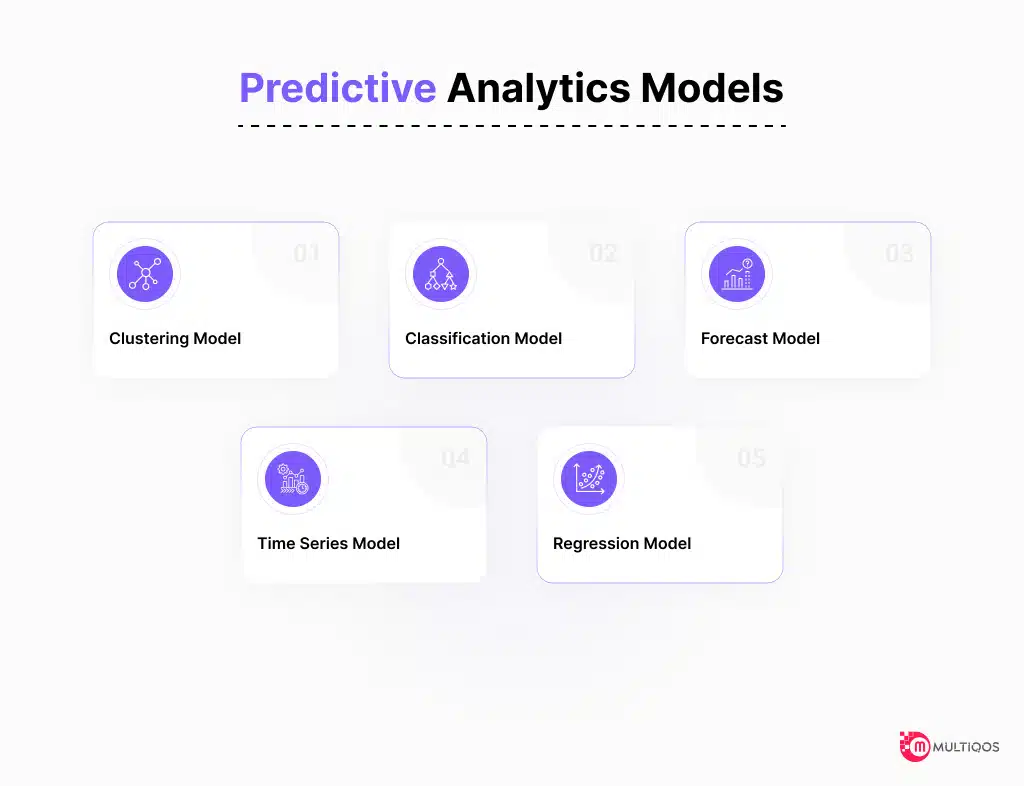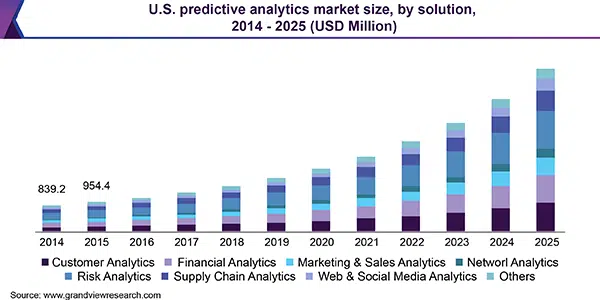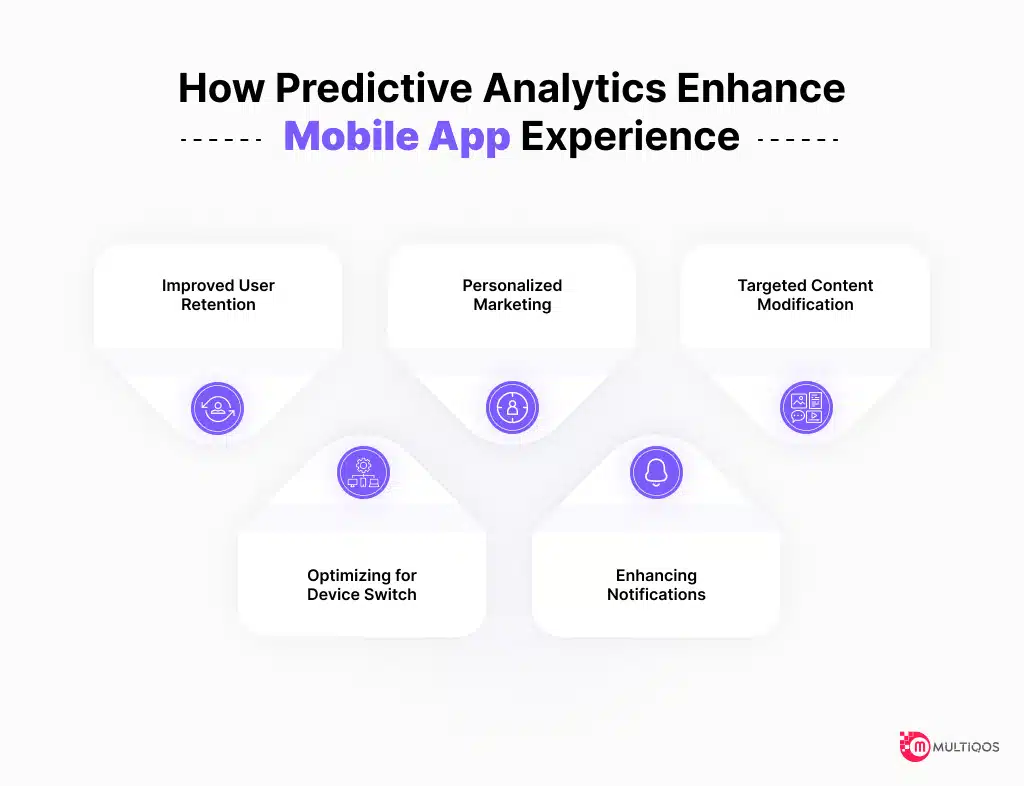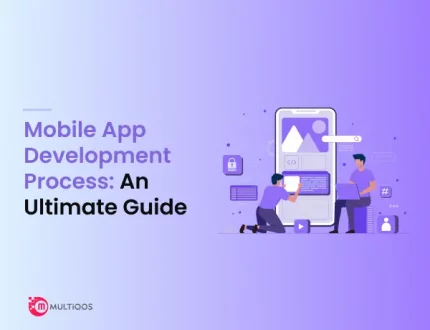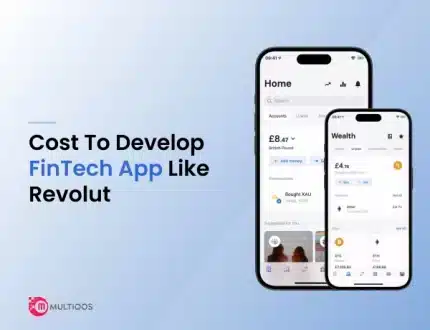How Does Predictive Analytics Transform Mobile App Future?
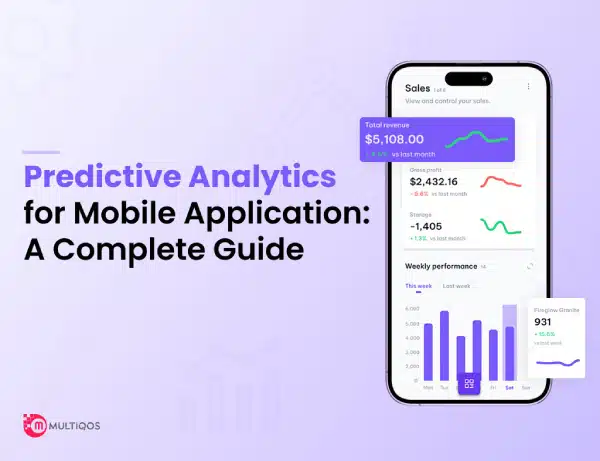
Keeping a technical perspective in mind, predictive analytics or predictive modeling involves utilizing mathematical methods and algorithms. It is a trusted approach to anticipating the likelihood of a specific event. Put simply, it’s a process that helps determine the potential benefits and drawbacks for you or your business.
How so?
Well, predictive modeling mobile apps are centered around making accurate predictions about future outcomes based on historical or current data. It employs various analytics techniques and statistical algorithms that enable businesses to swiftly forecast behaviours and trends, often in a matter of seconds.
This technology has gained widespread popularity across diverse organizations, and it is projected to reach a substantial market size of USD 28.1 billion by 2026, with an impressive compound annual growth rate (CAGR) of 21.7% from 2021 to 2026. Several factors, such as product launches, acquisitions, and increased utilization of machine learning and artificial intelligence, foster the widespread adoption of predictive analytics in the present-day market.
What are the Different Predictive Analytics Models?
AI in mobile app analytics leverages various models and algorithms suitable for diverse use cases. Selecting the most fitting predictive modeling techniques for your business is crucial to extract valuable insights from the data and make informed decisions.
Here are the top five predictive analytics models to consider:
- Clustering Model: The clustering model organizes data into distinct, nested groups based on similar attributes. This model allows businesses to categorize customers into relevant segments defined by shared characteristics swiftly. It enables the formulation of targeted strategies for each group effectively.
- Classification Model: The classification model categorizes data based on patterns learned from historical data. This model delivers a comprehensive analysis that facilitates decisive actions and decision-making. So, it is ideal for addressing binary questions (yes or no).
- Forecast Model: It is the most widely used predictive analytics model. The forecast model predicts metric values and estimates numerical outcomes for new data based on insights gleaned from historical data.
- Time Series Model: The time series model involves a sequential arrangement of data points, utilizing time as the input parameter. Drawing from last year’s data, this model generates numerical metrics to forecast three to six weeks’ worth of data.
Source: GrandViewResearch
Optimizing Mobile App Performance through Predictive Analytics
There are multiple ways in which businesses can utilize predictive analytics to enhance the overall experience of their data-driven mobile apps.
- Improved User Retention: It significantly enhances user retention by giving businesses valuable insights into how users interact with their apps and preferences. By identifying user behaviour patterns, entrepreneurs can address issues and improve features that attract and retain users.
- Personalized Marketing: Personalized marketing is a hallmark of predictive analytics. It is evident in apps like Spotify’s recommended playlists. By implementing predictive analytics, mobile apps can offer users personalized content and messages, creating a customized experience.
- Targeted Content Modification: Predictive analytics helps identify problematic app elements or screens causing user drop-offs. This empowers entrepreneurs to focus on improving specific segments rather than overhauling the entire application.
- Optimizing for Device Switch: Effective use of predictive analytics reveals the devices and operating systems users prefer for app usage. This information guides developers in optimizing their apps to cater to specific devices and platforms.
- Enhancing Notifications: It aids in understanding how different notification messages impact user responses. Marketers can then tailor notification pushes to achieve the most favourable outcomes.
By segmenting mobile app users based on their interactions and behaviours, predictive analytics solution assists marketers in delivering targeted push notifications and content. This approach ensures more effective engagement with different user groups.
How to Utilize Predictive Analytics in Mobile App Development?
Predictive analytics enhances clarity and insight for making well-informed business decisions. Thus, its integration into mobile app development brings greater efficiency. Let’s explore how predictive analytics accelerates mobile app development:
- Predictive Planning: Utilizing predictive analytics in mobile apps allows for identifying repetitive errors that may lead to bugs in the code. It also analyzes the developers’ coding productivity, such as the total number of code lines and the time to write them. This data helps determine whether the specified delivery date can be met.
- Predictive Analytics in DevOps: The integration of DevOps in mobile app development aims to expedite the delivery of applications. By employing predictive analytics, the development team can identify coding processes that may result in a subpar user experience for customers in the market, thus ensuring smooth operations.
- Predictive Testing: Traditional testing involves various combinations of user interfaces and actions with different systems. On the other hand, predictive analytics focuses on detecting commonly used paths by users and pinpointing the stages where the mobile app crashes. Algorithms analyze shared factors among user execution flows, revealing overlapping patterns that indicate common execution paths.
How Does Predictive Analytics Function?
Predictive Analytics generates future projections, akin to how meteorologists employ atmospheric data for weather forecasts. This approach involves the integration of artificial intelligence, data analysis, and machine learning components. The mobile app impact data analytics in business begins with a specific objective: cost reduction, enhanced employee retention, or time savings.
The workflow of predictive analytics tools in businesses may vary based on the industry and goals. However, in general, it follows these essential steps:
Step 1. Defining the Problem
The predictive analysis starts with a well-defined hypothesis and a set of requirements. Clearly defining the problem at hand helps determine the appropriate predictive analytics method.
Step 2. Acquiring and Organizing the Data
Businesses often possess a wealth of historical data that can be utilized. Before developing predictive analytics models, identifying the data sources and organizing data flows is crucial.
Step 3. Developing Predictive Models
Data scientists use various tools and techniques to build predictive models depending on the problem and dataset characteristics. Regression models and machine learning algorithms are among the most common types of predictive models.
Step 4. Pre-Process Data
Before feeding data into predictive analytics models, a preprocessing step is performed to clean the data and remove anomalies, extreme outliers, or missing data points that might arise due to input or measurement errors.
Step 5. Validate and Deploy the Models
The accuracy of the predictive models is evaluated, and adjustments are made as necessary. Once satisfactory results are achieved, the models are made available to stakeholders via websites, apps, or dashboards.
Illustrative Examples of Predictive Analytics
Predictive data analytics is instrumental in businesses identifying target consumers through collected data. Implementing predictive data analytics solutions in apps improves business intelligence by analyzing users’ previous searches and history. Let’s explore some examples of how applying predictive analytics has benefited businesses:
- Netflix: With its digital transformation, Netflix leverages vast amounts of user data, including preferred genres, viewing history, and language preferences, to deliver personalized content recommendations. These viewing suggestions account for over 80% of the content users stream, contributing significantly to Netflix’s success.
- Siri: Siri, one of the most popular voice assistants, relies on predictive analytics to cater to users’ needs. The app tailors its recommendations based on users’ past searches and history, leading to a high satisfaction rate of 81% among users.
- Spotify: Through various campaigns, Spotify enhances user engagement by implementing predictive analytics in its app. A prominent example is the ‘Wrapped Campaign,’ where Spotify provides users with a summary of their listening habits at the end of the year.
These businesses have improved their offerings by embracing mobile app user behavior analysis. It also deepened their understanding of their user base, leading to enhanced user satisfaction and engagement. Having explored the pivotal role of predictive analytics in the mobile app development industry for development agencies and businesses, the next step is to explore use cases for integrating analytics into mobile apps across various industries.
Also Read: Bootstrap vs React: Choose the Right Frontend Framework
Industry-wise Application of Predictive Analytics
Predictive analytics finds versatile applications across various industries, addressing multiple business challenges. Below are some use cases that illustrate how predictive analytics can profoundly influence decision-making in real-world scenarios:
-
Predictive Analytics in Healthcare Industry
AI app development services utilize predictive analytics in healthcare for detecting and overseeing the care of patients with chronic illnesses. The growing prevalence of mobile applications in the healthcare sector has facilitated more accessible access to health records. Leveraging predictive analytics, health records can be examined to gain insights into past diagnoses and treatment approaches for specific diseases. This approach has demonstrated promising outcomes and contributed to improved patient treatments.
-
Predictive Analytics in Retail and E-commerce
Predictive analytics assists users with product recommendations like “Customers who bought this also bought. Further, it also displays targeted ads featuring offers on items they previously considered or added to their shopping cart. It helps retain user engagement by providing tailored offers and discounts on desired products. It is coupled with aiding users in purchasing decisions to integrate predictive analytics into their websites and mobile apps.
-
Predictive Analytics in Financial Services
Financial services extensively leverage machine learning and quantitative tools to forecast credit risk and identify fraudulent activities. Predictive analytics applications empower financial institutions to adapt to market fluctuations effectively. Additionally, these applications enable customized, personalized services for clients, thereby reducing risks and enhancing overall customer satisfaction.
-
Predictive Analytics in Manufacturing and Supply Chain
Predictive analytics for mobile applications are widely employed by businesses to handle product inventory and establish optimal pricing strategies efficiently. By doing so, companies can effectively meet customer demands without the risk of overstocking their warehouses. Furthermore, this approach allows businesses to assess the cost and return on their products over time, aiding in strategic decision-making.
-
Predictive Analytics in Marketing and Advertising
Marketing and sales teams are well-acquainted with business intelligence reports for comprehending sales performance. Nonetheless, predictive analytics empowers companies to adopt a more proactive approach to engaging with their clients throughout the entire customer lifecycle.
-
Predictive Analytics in Weather Forecasting
Predictive analytics goes beyond its application areas in various fields, including climate and temperature-related mobile apps. Within the meteorological department, it is used to analyze weather patterns, enabling accurate and precise weather forecasting.
How MultiQoS Can Help in Integrating Predictive Analytics in Mobile Apps?
The integration of predictive analytics in mobile app development can yield several benefits. It includes heightened user retention rates, precision-targeted marketing campaigns, and personalized interactions with app users. For businesses seeking to develop a mobile app seamlessly integrated with predictive analytics, MultiQoS stands out as the ideal choice. MultiQoS stands out as the foremost mobile app development company, catering to a wide range of industry verticals on a global scale.
They amalgamate cutting-edge data analytics solutions into mobile app development. Thus, businesses can continually enhance their offerings and expand their app’s capabilities with the latest features. The adept team of professionals at MultiQoS, the best big data analytics services provider, also excels in identifying target markets and studying consumer behavior patterns while using the app.
Conclusion
Predictive analytics, an advanced approach to app analytics, provides valuable foresight into your app’s future, enabling informed decision-making and a competitive edge. Organizations can leverage predictive analytics to take proactive measures across various domains. Its applications include enhancing user retention, personalization, targeted marketing campaigns, and more, making it a valuable asset for the future.
If you aim to build a mobile app successfully using predictive analytics, seeking guidance from an experienced big data app development company like MultiQoS is advisable. Additionally, staying vigilant for new data analytics solutions allows for continuous improvements, gradually transforming your application into a more advanced and feature-rich product.
Boost App Experiences with Predictive Analytics!
Our team of expert developers specializes in crafting predictive analytics solutions tailored to large and small enterprises.
FAQ on Predictive Analytics in Mobile Apps
Businesses can gain valuable insights into app performance by incorporating predictive analytics into mobile applications. This helps understand user engagement and allows for focusing on future user preferences based on accumulated data.
Predictive analytics finds practical applications in various industries, including banking, retail, insurance, and telecommunications, among others. These sectors leverage predictive analytics to enhance outcomes and proactively respond to future events.
Using predictive analytics for mobile apps effectively comes with specific challenges, such as ensuring the collection of relevant data, finding the right expertise, encouraging user adoption, and developing a clear strategy.
Predictive analytics involves four steps: data collection, data preprocessing, model building, and model deployment/evaluation.
Common ML algorithms for prediction include Linear Regression, Decision Trees, Random Forest, Support Vector Machines, and Neural Networks.
Predictive analytics in ML uses historical data to build models that predict future outcomes, aiding decision-making in various fields.
Get In Touch

